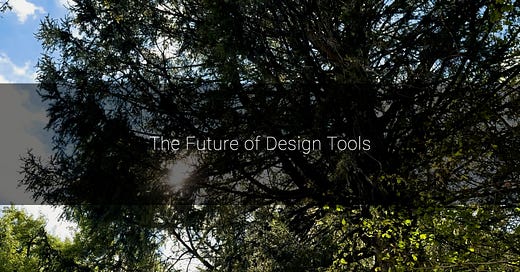The Future of Design Tools
The future of design won’t be typed.
It won’t be clicked.
It’ll be spoken.
We’re standing at the edge of a shift that will upend everything we know about creative work.
A convergence is coming - voice control, general AI, vibe coding, and something much older than any of them.
Humanity.
The magic dust that makes art feel like art.
The spark that makes design resonate.
And here’s the big shift:
Soon, you won’t be the one pushing pixels.
You’ll be the one guiding the team.
Only now, the team is AI.
And your tool is your voice.
Watch the video version of this vision here:
Designing like a Creative Director
Imagine walking into a room and describing what you want - tone, vibe, energy, structure - and watching it unfold in real time.
No keyboard. No mouse.
Just your voice. Just your vision. Just your taste.
We’re not far off.
We already search our TVs by speaking into a remote.
We dictate texts, write emails, book meetings - all with our voice.
We ask AI to draft copy, generate visuals, write code, and shape strategy.
Now imagine that same ecosystem tuned to you.
“Make it feel like Nike in the 90s. Build it modular.
Give me three versions - cleaner grid, punchier contrast.
And bring the type to life just enough to feel bold, not loud.”
That’s not fantasy.
That’s next year.
What gets left behind
This is bigger than automating ad resizes or landing pages.
This shift will sweep through the industry like water finding cracks.
Quietly, relentlessly, and completely.
If your value lies in repetition or repackaging, AI is coming for your job.
And it’s not just designers.
If you’re a researcher or a strategist, you should be paying attention.
AI is already:
Synthesising 100 user interviews in seconds
Auditing entire markets while you’re making your second coffee
Generating personas, journeys, decks, and narratives
Spotting patterns deeper and faster than we ever could
That used to be the thinking part of the process.
Now, it’s becoming the default output of every AI-powered tool.
So where does that leave us?
Storytelling. That’s what remains. And that’s what always mattered.
Not the fluffy kind.
Real storytelling.
The kind a researcher uses to pull humanity out of cold data.
To connect behaviour to emotion, and find the heartbeat in the numbers.
The kind a strategist uses to link fragments into a plan with power.
A narrative arc with lift-off, velocity, and an ending that makes people act.
And the kind a designer uses to bring it all to life.
To create something that reflects the data, the strategy, the business goals - and still hits the user right in the feels.
The best designers have always done this.
We’ve always been the ones telling the story - just with visuals, layout, motion, rhythm.
Now we’ll do it with voice too.
Picture this
You walk into a room. Say a single sentence.
Three concepts appear on the wall. You refine them aloud.
You shift the energy, change the layout, tighten the message.
By the time the team arrives, the work is ready.
But your real job is just beginning.
You still need to explain why it works.
To guide the client, connect the dots, and sell the idea.
That’s where leadership lives now.
Of course: As we move toward voice-led tools, we also need to design for adaptability. Not everyone can use their voice - and inclusion has to be built into the foundations, not bolted on later. The future needs to be flexible enough to work for all of us.
If you lead, start now.
If you’re mentoring designers, start sharpening this skill.
Get them presenting work aloud.
Challenge them to describe visual choices before showing the outcome.
Ask them to tell the story behind their design - not just show the final slide.
Because in a voice-first world, clarity becomes currency.
And if AI can build the work, your job is to make it matter.
The future of design is voice-first.
Heart-led.
Human at the centre.
Don’t fight the change.
Lead it.
Speak it into existence.
And if you’d like to support this work with a one-off thank-you, you can do that here → Support Grow With Adam




